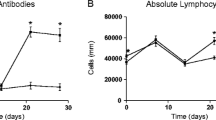Abstract
Gilthead sea bream, Sparus aurata, were subjected to different stressful situations and the haemolytic activity mediated by the alternative complement and the agglutinating serum activity were tested as indicators of immunocompetence. The results show that both parameters were significantly compromised after chronic or repeated acute stress as well as in groups fed with vitamin E or Ω3 highly unsaturated fatty acids (HUFA) deficient diets and in infected fish. These results suggest that both haemolytic and agglutinating activity are suitable indicators for immunocompetence as they are non-specific responses induced by non-specific stressors. In addition, a comparison is performed with other immune indicators subjected to the same stressors.
Similar content being viewed by others
References
Ainsworth, A.J. Dexiang, C. and Waterstrat, P.R. (1991) Changes in peripheral blood leukocyte percentages and function of neutrophils in stressed channel catfish. Journal of Aquatic Animal Health 3, 41–47.
Amano, Y., Lee, S.W. and Allison, A.C. (1993). Inhibition by glucocorticoids of the formation of interleukin-1α, interleukin-1β, and interleukin-6: mediation by decreased mRNA stability. Molecular Pharmacology 43, 176–182.
Anderson, D.P. (1990) Immunological indicators: effects of environmental stress on immune protection and disease outbreaks. American Fisheries Society Symposium 8, 38–50.
Blazer, V.S. and Wolke, R.E. (1984) The effects of α-tocopherol on the immune response and non-specific resistance factors of the rainbow trout (Salmo gairdneri Richardson). Aquaculture 37, 1–9.
Chung, S. and Secombes, C.J. (1988) Analysis of events occurring within teleost macrophages during the respiratory burst. Comparative Biochemistry and Physiology 89, 539–544.
Ellsaesser, C.F. and Clem, L.W. (1986) Haematological and immunological changes in channel catfish stressed by handling and transport. Journal of Fish Biology 28, 511–521.
Fries, C.R. (1986) Effects of environmental stressors and immunosuppressants on immunity in Fundulus heteroclitus. American Zoologist 26, 271–282.
Hardie, L.J., Fletcher, T.C. and Secombes, C.J. (1990) The effect of vitamin E on the immune response of the Atlantic salmon (Salmo salar L.). Aquaculture 87, 1–13.
Houston, A.H. (1990) Blood and circulation. In: Methods for Fish Biology (eds C.B. Schreck and P.B. Moyle) American Fisheries Society: Bethesda MD, pp. 273–334.
Ibeas, C., Izquierdo, M.S. and Lorenzo, A. (1994) Effect of different levels of Ω highly unsaturated fatty acids on growth and fatty acid composition of juvenile gilthead seabream (Sparus aurata). Aquaculture 127, 177–188.
Kaatari, S.L. and Tripp, R.A. (1987) Cellular mechanisms of glucocorticoid immunosuppression in salmon. Journal of Fish Biology 31 (Suppl. A), 129–132.
Khansari, D.N., Murgo, A.J. and Faith, R.E. (1990) Effects of stress on the immune system. Immunology Today 11, 170–175.
Landman, R.M.A., Muller, F.B., Perini, C., Wesp, M., Erne, P. and Buhler, F.R. (1984) Changes of immunoregulatory cells induced by psychological and physical stress: Relationship to plasma catecholamines. Clin. Exp. Immunol. 58, 127–135.
Lappin, D.F. and Whaley, K. (1991) Modulation of complement gene expression by glucocorticoids. Biochemical Journal 280, 117–123.
Li, Y. and Lowell, R.T. (1985) Elevated levels of dietary ascorbic acid increase immune responses in channel catfish. Journal of Nutrition 115, 123–131.
Maule, A.G. and Schreck, C.B. (1990) Glucocorticoid receptors in leukocytes and gill of juvenile coho salmon (Oncorhynchus kisutch). General and Comparative Endocrinology 77, 448–455.
Maule, A.G. and Schreck, C.B. (1991) Stress and cortisol treatment changed the affinity and number of glucocorticoid receptors in leukocytes and gill of Coho salmon. General and Comparative Endocrinology, 84, 83–93.
Maule, A.G., Schreck, C.B. and Kaatari, S.L. (1987) Changes in the immune system of coho salmon (Oncorhynchus kisutch) during the parr-smolt transformation and after implantation of cortisol. Canadian Journal of Fisheries and Aquatic Sciences, 44, 161–166.
Maule, A.G., Tripp, R.A., Kaatari, S.L. and Schreck, C.B. (1989) Stress alters the immune function and disease resistance in chinook salmon Oncorhynchus tsawytscha. Journal of Endocrinology, 120, 135–142.
Molinero, A. and Gonzalez, J. (1995) Comparative effects of MS 222 and 2-phenoxyethanol on gilthead sea bream (Sparus aurata L.) during confinement. Comparative Biochemistry and Physiology 111, 405–414.
Nagae, M., Fuda, H., Ura, K., Kawamura, H., Adachi, S., Hara, A. and Yamauchi, K. (1994) The effect of cortisol administration on blood plasma immunoglobulin M (IgM) concentrations in masu salmon (Oncorhynchus masou). Fish Physiology and Biochemistry 13, 41–48.
Pickering, A.D. and Pottinger, T.G. (1985) Cortisol can increase the susceptibility of brown trout Salmo trutta L. to disease without reducing white blood cell count. Journal of Fish Biology 27, 611–619.
Sheldon, W.H. and Blazer, V.S. (1991) Influence of dietary lipid and temperature on bactericidal activity of channel catfish macrophages. Journal of Aquatic Animal Health 3, 87–93.
Stolen, J.S., Fletcher, T.C., Anderson, D.P., Roberson, B.S. and Van Muiswinkel, W.B. (1990) Techniques in Fish Immunology. SOS Publications: Fair Haven, NJ. 197 pp.
Sunyer, J.O. and Tort, L. (1995) Haemolytic and bacteriolytic activities of sea bream serum are mediated by the Alternative Complement Pathway. Veterinary Immunology and Immunopathology 45, 333–345.
Sunyer, J.O., Gómez, E., Navarro, V., Quesada, J. and Tort, L. (1995) Depression of humoral components of the immune system and physiological responses in gilthead sea bream Sparus aurata from daily acute stress. Canadian Journal of Fisheries and Aquatic Sciences (In press).
Thompson, I., White, A., Fletcher, T.C., Houlihan, D.F. and Secombes, C.J. (1993) The effect of stress on the immune response of Atlantic salmon (Salmo salar L.) fed diets containing different amounts of Vitamin C. Aquaculture 114, 1–18.
Author information
Authors and Affiliations
Rights and permissions
About this article
Cite this article
Tort, L., Gómez, E., Montero, D. et al. Serum haemolytic and agglutinating activity as indicators of fish immunocompetence: their suitability in stress and dietary studies. Aquacult Int 4, 31–41 (1996). https://doi.org/10.1007/BF00175219
Issue Date:
DOI: https://doi.org/10.1007/BF00175219




